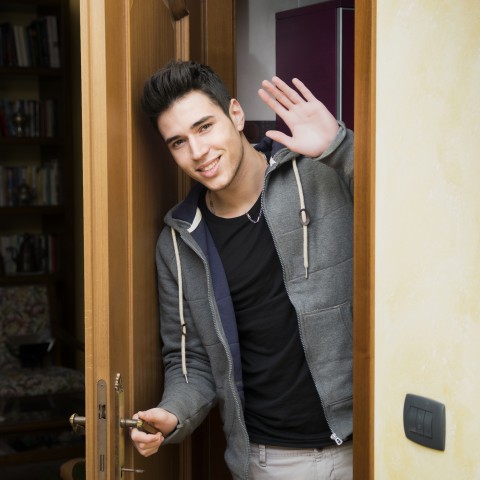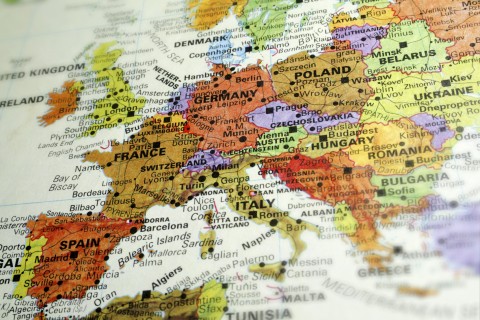Even if you don’t actually have the intention of learning a language, being able to say hello to someone when you’re traveling makes you look good. We all know this, don’t we? You just need to try not to pronounce it too well, so that they don’t mistake you for a native speaker—because we’re sure you’d rather not have to stand there awkwardly while they talk to you in a language you don’t know!
However, if you do want to learn a language, it’s extremely important that you know how to greet someone in different ways for various occasions. This is why today, at SpanishPod101.com, we’ll show you how to say “hello” or “good morning” in Spanish—as well as in the other languages that are spoken in Spain—for everyone who wishes to learn Spanish or perhaps just travel to Spain.
So without further ado, here’s our guide on Spanish greetings and introductions!
1. Five Different Ways of Saying “Hello” in Spanish (Spain)
Just like in English, and probably most (if not all) languages, Spanish has more than one way of greeting someone. As you might already know, the most common word is Hola, which can be used at any time of the day, in any situation, either formally or informally, and all over Spain or any Spanish-speaking country. It’s short, simple, and all you need to remember is that in Spanish we don’t pronounce the letter h.
We’ve made a list of all the most common Spanish greetings you should know if you want to start learning European Spanish.
1- Hola
It means “hello” or “hi” in Spanish and, as we’ve already mentioned, this word is the most common Spanish greeting and can be used at all times.
2- Buenos días
It literally means “good days” and is generally used in the morning, so it’s the equivalent of “good morning,” in English. This expression is usually more formal than the simple hola, but it can also be used in informal contexts.
Maybe you noticed that when we translated it literally, we wrote “good days,” in the plural. No, it wasn’t a mistake. In Spanish, for some reason, all these greetings are in the plural. Just so you know, we’ll just translate the two following phrases in the singular, as that’s the equivalent in English, even though they are also in the plural.
3- Buenas tardes
This phrase translates to “good afternoon,” and it’s commonly used between noon and sunset. Just like buenos días, this expression also tends to be more formal than simple hola.
4- Buenas noches
This one’s a little different than in English, because it translates to both “good evening” and “good night.” This is because in Spanish, there’s no word for “evening,” so we use the word “night” for both. Notice that in English, “good night” is generally used when someone is going to sleep, or when it’s nighttime and you don’t think you’re going to see this person again, so it’s more of a “goodbye” than a “hello.” In Spanish, however, it can be used as both. This means that, as soon as the sun sets, you can greet someone by saying “¡Buenas noches!” but you can also wish them a good night in the same way.
5- Ey
This greeting is also another word for “hello,” and as you might have guessed, it’s basically equivalent to “hi” or “hey” in Spanish. Just a short and easy word. Ey. But of course, the fact that it’s short and easy means it’s not appropriate for formal events, so you only use this word when greeting a friend.
2. Four Different Ways of Saying “How are you?” in Spanish
In English, you can also greet someone by asking “How are you?” or with similar expressions. This is also possible in Spanish, so now we’re going to see a few common ways to do it. This should answer your question of how to say “how are you?” in Spanish, so that you can greet with flying colors.
1- ¿Cómo estás?
This translates to “How are you?” To be honest, there’s not much we can say about it. Basically, it can be used any time.
2- ¿Qué tal?
This is just another way of asking “How are you?” but in a slightly informal way. Or at least that’s what the theory says, because the truth is, you’ll hear this everywhere. You can also add the word todo (which means “all”) at the end, as in ¿Qué tal todo?, and this way, the person you asked won’t only tell you how they are, but also make a reference to how their job is going, or how their family is. This is because this question’s meaning is changed to “How is it all going?”
3- ¿Qué pasa?
This expression literally means “What’s happening?” and is equivalent to the English “What’s up?” in Spanish, but it’s not as widely used as in English. However, just like in English, it’s an informal expression, unless you actually want to ask what has happened.
4- ¿Cómo va?
This is another commonly used Spanish expression that translates to “How is it going?” Just like in ¿Qué tal?, we can also add todo at the end of the question and say ¿Cómo va todo? so that it means “How is it all going?”
3. How to Greet in Spanish
Just like in other languages and cultures, sometimes greeting isn’t all about the words you say. Spanish greeting body language is pretty important to consider before visiting the country. In Spain, there are some particular ways of greeting someone.
If the greeting is between a woman and a man or a woman and another woman—or between kids—the most usual greeting is called dos besos and means to kiss them twice: once on each cheek, always starting by leaning to your left side, which is their right cheek. Notice that in other countries, such as France, they start on the other side.
However, if you’re a man and you’re greeting another man, you should always go for a handshake. If you’re close friends, you can hug him or pat his back, and if he’s a member of your family, you can also give him dos besos or kiss him on the cheeks, like we explained just before.
Going back to the words we use, it’s really helpful for you to know that you can combine some of these greetings with each other. For instance, you can put hola in front of anything; and there are still some others you can combine.
But keep in mind that this doesn’t apply to all of them, which is just common sense: you wouldn’t say “Good morning, good night” to someone, unless you woke up after a big nap (or siesta) and got confused, or are talking to your friend on the other side of the world, who wakes up when you go to bed, or vice versa.
But you can mix pretty much all the others. Just like in English, you wouldn’t say “How are you? Hello!”, but you would start by saying “Hello.” Here are some examples:
-
- Hola, buenos días.
- Hola, ¿qué tal?
- Buenas noches, ¿cómo estás?
- Ey, ¿cómo va?
You could even say this and it wouldn’t sound weird:
- ¿Qué tal, cómo estás?
We bet you’re thinking: “But you just said ‘How are you?’ twice!” Well, yes, that’s exactly what it is. You would be surprised at how often we say this.
As you can see, there are several ways of saying hello and greeting people in Spanish—so explore a little bit and see how colorful your Spanish greetings and introductions can become!
4. How to Answer the Phone in Spain
To complete the previous lists, we thought it would be useful to know how to answer the phone in Spanish. You never know if you’ll need it! Here are a few common ways of answering the phone in Spanish if you get a call when it’s needed.
1- ¿Hola?
We’ve already learned that Hola means “Hello”. This greeting, when turned into a question, is also a very common way of answering the phone in Spanish. It’s not a formal way of doing it, but it can still be used most times.
2- ¿Diga? or ¿Dígame?
These two different ways of answering the phone are slightly more formal than answering with ¿Hola?, especially the second one, ¿Dígame?. They both mean “Tell me?” in Spanish.
3- ¿Sí?
This last expression on the list means “Yes” and is a really simple and informal way of answering the phone, though it’s still really common in some regions in Spain.
5. Greetings in Other Languages Spoken in Spain
Spain is a multilingual country, which means that, while Spanish is the only official language and it’s spoken everywhere you go in Spain, there are a few regions that have co-official languages. Even though everyone (or nearly everyone) speaks and understands Spanish, it might be helpful to know a few basic phrases in these regional languages, depending on what city you choose to visit. You may or may not have heard of these languages before, but they are actually pretty important.
For example, if you visit Barcelona, you should know that Catalan is widely spoken there. Or if you visit Valencia, you’ll hear some people speaking Valencian, or read signs that aren’t in Spanish. We won’t get into details, but there is a debate on whether Valencian and Catalan are different languages or dialects of the same language. Either way, don’t worry about it, they’re pretty similar.
Another language we have is Galician, which you might hear if you visit Santiago de Compostela. And last but not least, there is Basque, which is spoken in cities including Bilbao and San Sebastián, and is completely different than all these other languages spoken in Spain. But not just that: it’s also completely different than any other language in the world. WHAT!? That’s right. We have no idea how this happened, but it’s not related to any other known language.
Let’s take a quick look at some greetings in these other languages, along with their English translations:
- Catalan/Valencian:
- Hola = “Hello” (Lucky for you, Spanish, Catalan, and Valencian share this word, so that makes things easier)
- Bon dia = “Good day”
- Bona tarda = “Good afternoon”
- Bona vesprada = “Good evening” – only in Valencian. (Note: Catalan also has a word for “evening,” which is vespre, but the expression bon vespre isn’t used anymore.)
- Bona nit = “Good night”
- Galician:
- Ola = “Hello” (Galician has a slightly different spelling of the word Hola, but it has the same pronunciation)
- Bos días = “Good day”
- Boas tardes = “Good afternoon”
- Boas noites = “Good night”
- Basque (I told you this language was completely different than the others!):
- Kaixo = “Hello”
- Egun on = “Good morning”
- Arratsalde on = “Good afternoon”
- Gabon = “Good night”
And hey, just to surprise you a little more, there are actually a few more regional languages: Aranese, Aragonese, Asturian, and Leonese. These languages aren’t official, except for Aranese, and they’re only spoken by minorities, so don’t worry about them.
Hopefully this additional list has given you the ability and confidence to master not only Spanish greetings, but every other greeting you’ll need for your trip to Spain.
6. How SpanishPod101 Can Help You Learn More Spanish
So now you know how to say words like “hello” and “good afternoon” in Spanish. Was that too hard? We don’t think so. If you can’t remember what you should say throughout the day, just keep in mind that hola will work every single time!
And now…what’s next?
Maybe you could try learning a few more simple words and phrases, and very soon, start having basic conversations! Get started by checking out the Top 15 Spanish Questions You Should Know for Conversations! Or how about learning how to introduce yourself with 10 Spanish Lines You Need for Introducing Yourself?
At SpanishPod101.com, you’ll learn other useful expressions like the ones you just learned, and so much more!
So for now, take the knowledge you learned in this Spanish greetings guide and work your way up to the top of the language success ladder!
















